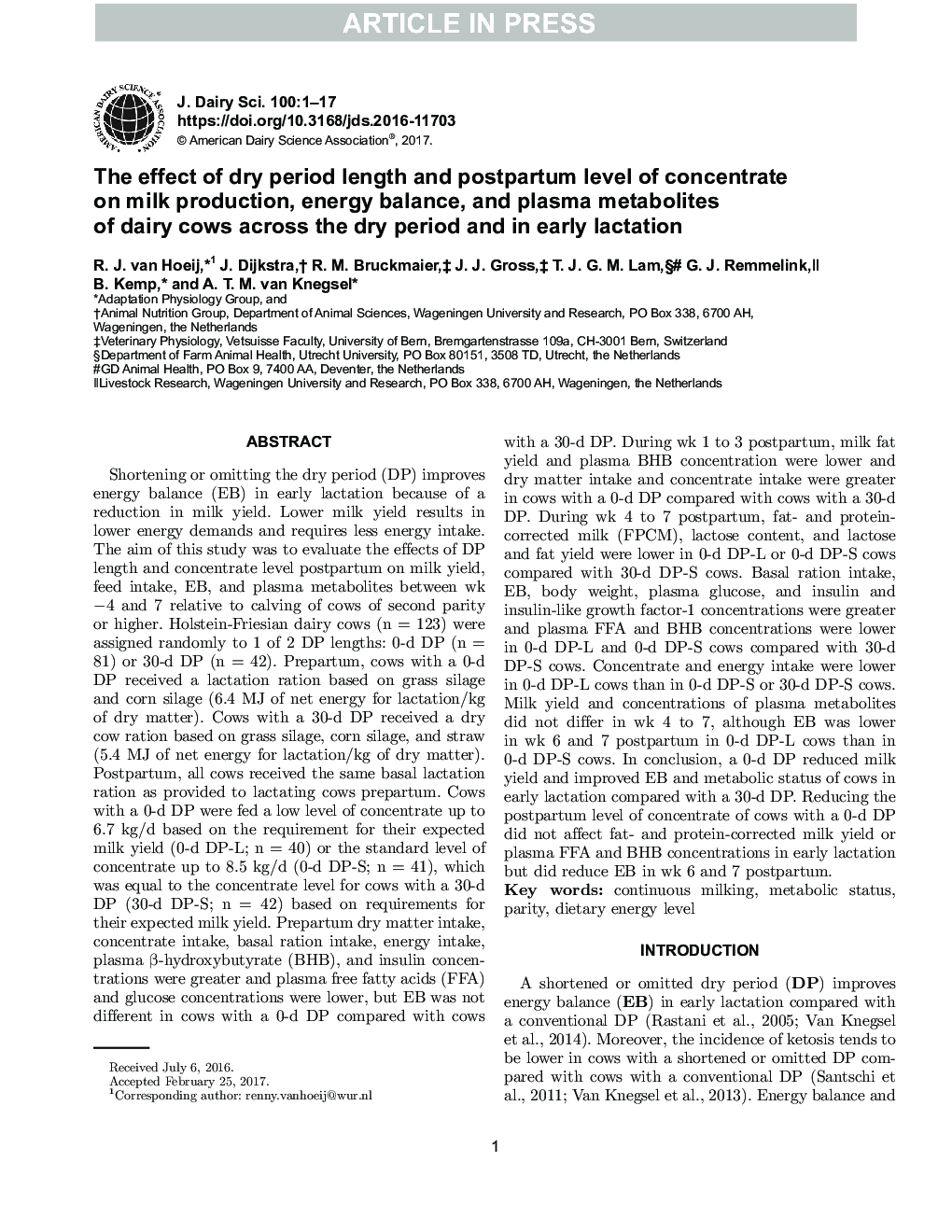| Article ID | Journal | Published Year | Pages | File Type |
|---|---|---|---|---|
| 5541786 | Journal of Dairy Science | 2017 | 17 Pages |
Abstract
Shortening or omitting the dry period (DP) improves energy balance (EB) in early lactation because of a reduction in milk yield. Lower milk yield results in lower energy demands and requires less energy intake. The aim of this study was to evaluate the effects of DP length and concentrate level postpartum on milk yield, feed intake, EB, and plasma metabolites between wk â4 and 7 relative to calving of cows of second parity or higher. Holstein-Friesian dairy cows (n = 123) were assigned randomly to 1 of 2 DP lengths: 0-d DP (n = 81) or 30-d DP (n = 42). Prepartum, cows with a 0-d DP received a lactation ration based on grass silage and corn silage (6.4 MJ of net energy for lactation/kg of dry matter). Cows with a 30-d DP received a dry cow ration based on grass silage, corn silage, and straw (5.4 MJ of net energy for lactation/kg of dry matter). Postpartum, all cows received the same basal lactation ration as provided to lactating cows prepartum. Cows with a 0-d DP were fed a low level of concentrate up to 6.7 kg/d based on the requirement for their expected milk yield (0-d DP-L; n = 40) or the standard level of concentrate up to 8.5 kg/d (0-d DP-S; n = 41), which was equal to the concentrate level for cows with a 30-d DP (30-d DP-S; n = 42) based on requirements for their expected milk yield. Prepartum dry matter intake, concentrate intake, basal ration intake, energy intake, plasma β-hydroxybutyrate (BHB), and insulin concentrations were greater and plasma free fatty acids (FFA) and glucose concentrations were lower, but EB was not different in cows with a 0-d DP compared with cows with a 30-d DP. During wk 1 to 3 postpartum, milk fat yield and plasma BHB concentration were lower and dry matter intake and concentrate intake were greater in cows with a 0-d DP compared with cows with a 30-d DP. During wk 4 to 7 postpartum, fat- and protein-corrected milk (FPCM), lactose content, and lactose and fat yield were lower in 0-d DP-L or 0-d DP-S cows compared with 30-d DP-S cows. Basal ration intake, EB, body weight, plasma glucose, and insulin and insulin-like growth factor-1 concentrations were greater and plasma FFA and BHB concentrations were lower in 0-d DP-L and 0-d DP-S cows compared with 30-d DP-S cows. Concentrate and energy intake were lower in 0-d DP-L cows than in 0-d DP-S or 30-d DP-S cows. Milk yield and concentrations of plasma metabolites did not differ in wk 4 to 7, although EB was lower in wk 6 and 7 postpartum in 0-d DP-L cows than in 0-d DP-S cows. In conclusion, a 0-d DP reduced milk yield and improved EB and metabolic status of cows in early lactation compared with a 30-d DP. Reducing the postpartum level of concentrate of cows with a 0-d DP did not affect fat- and protein-corrected milk yield or plasma FFA and BHB concentrations in early lactation but did reduce EB in wk 6 and 7 postpartum.
Related Topics
Life Sciences
Agricultural and Biological Sciences
Animal Science and Zoology
Authors
R.J. van Hoeij, J. Dijkstra, R.M. Bruckmaier, J.J. Gross, T.J.G.M. Lam, G.J. Remmelink, B. Kemp, A.T.M. van Knegsel,
